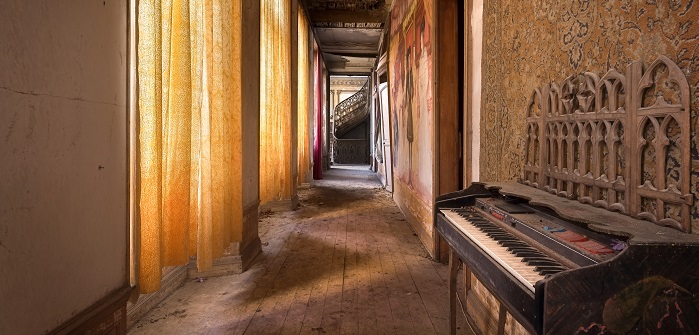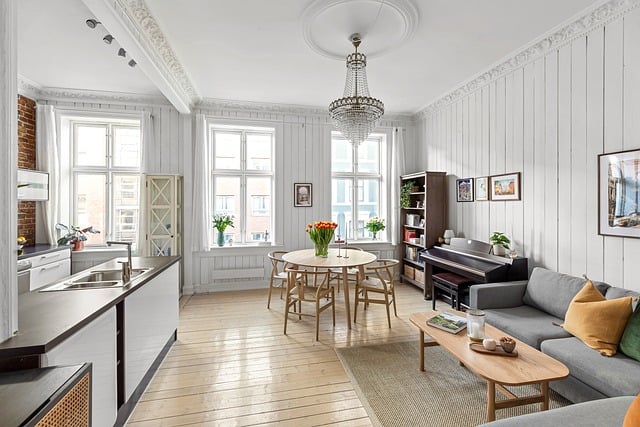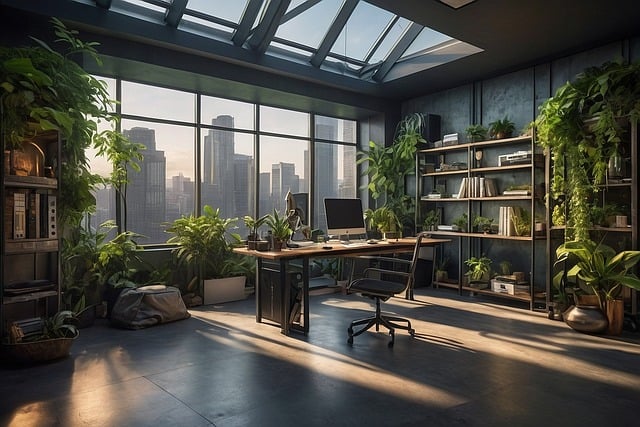Ideas for wall design in the hallway are not only exciting when you move. Redesigning the hallway also brings fresh air into the home and makes it more comfortable. You can find many ideas and tips for hallway design here, along with meaningful pictures of private and business areas. Get inspiration for your remodeling plans and decorating intentions from these 20 hallway wall design options!
Upgrade the Hallway With Clever Tricks
Various designs can successfully redesign the hallway and transform it into a place that welcomes you with open arms after the working day. Particular attention should be paid to personal details. Photos of memorable moments, vacations, family, and friends are fantastic accents, even in the hallway. So that you don’t even have to hammer holes in your newly designed hallway wall, we have picked out twenty hacks.
1. Colored Wall Design in the Hallway
The basis for a stylish hallway design is the color of the walls. Whether painted or wallpapered – color brings a fresh boost and puts you in a good mood. A particularly striking color is a warm and intense red, which can be used to decorate walls. Since an intense red is complex to paint over, red wallpaper is ideal for decorating the walls in the hallway. For example, it can be decorated with white, silver, gold, or black decorations. Beige and gray are suitable accents on a red hallway wall, depending on your taste. If you only paint one wall red, use the color again on another wall to achieve a harmonious color concept. For example, hang up a picture with a red motif, place a piece of furniture painted red, or use red curtains.
2. Two-tone Hallway Design
Instead of just choosing one color, you can bring even more accents into play with a two-tone wall design. Striped wallpapers enable two-tone wall decoration with comparatively little effort. Wallpaper with vertical stripes should be chosen, especially for narrow or winding hallways. They make the room appear visually higher. Striped wallpapers look very stylish when combined with baroque decorations.
This quickly gives the impression that the hallway could be part of an old mansion. Baroque decorative elements include ornately framed mirrors, velvet curtains, and upholstered stools. Wood carvings, busts, opulent vases with fresh flowers, and paintings are also suitable for stylish decoration in this wall design. This is especially true if the hallway section leads to the bathroom, bedroom, and guest room.
3. Ideas for Wall Design in the Hallway With a Photo Wallpaper
Specialist retailers offer a large selection of different photo wallpapers. Many motifs make the room appear larger and seemingly eliminate the rigid boundaries of the hallway wall. The selection ranges from the flower meadow to the jetty leading into the sea to the cloudy sky. When using photo wallpaper, it is essential that it is only stuck to one wall in the hallway and does not decorate all the walls.
The eye-catching pattern and the many details should be combined with a plain wall, ideally picking up a color from the photo wallpaper. What’s particularly practical about such photo wallpapers is that you can replace them with a new motif wallpaper in no time and create an entirely new wall design in the hallway with little effort. If a photo is too busy as a motif for wallpaper, you can also use a slightly less conspicuous patterned wallpaper instead.
4. Courage when designing the hallway: extravagant 3D motifs
You can use the hallway between the living room, children’s room, bathroom, kitchen, and bedroom for unusual wallpaper with a three-dimensional motif. As a result, the room loses shape and takes on a completely new look. With the elaborately designed 3D wallpapers, any additional wall decoration is unnecessary. After all, the wallpaper creates a striking wall design in the hallway that the viewer cannot get enough of. Ideally, when choosing the motif using three-dimensional printing technology, you should ensure that it does not make your hallway appear smaller but visually enlarges it. It can be helpful to just wallpaper one large wall and paint the opposite hallway wall in a simple color. You can then hang pictures or place small pieces of furniture on this neutral wall.
5. Transparent staircase
A beautifully designed wall will not be noticeable if a solid railing or a floating wall hides the staircase. Therefore, transparency is essential in hallway design in a home with internal stairs. A translucent material such as glass or plexiglass offers a clear view of the stairs and the wall behind them but still visually divides the area. With colored glass, you can also influence the lighting mood and the play of colors. A light coloring of the material is recommended here, which does not absorb too much brightness.
6. Filigree stair railing highlights wall design in the hallway
Another way to show off a staircase in the hallway is with a delicate staircase surround. For example, it can consist of thin struts or tightly stretched steel cables and should extend from the individual steps to the ceiling. With sufficient distance between the individual struts, daylight or artificial light penetrates the entire hallway area almost unhindered. You then have the opportunity to design the wall at the staircase according to your wishes. A striking patterned wallpaper, for example, is ideal for this purpose. It is also possible to highlight the natural material, not wallpaper or paint the wall.
7. Child-friendly Wall Design
On the way to the children’s room, the hallway can be decorated colorful and fun. The basis for this is a friendly color that can be optimally combined with other decorations. A light rosé, light blue, lime green, or a fresh yellow suit. The painted walls offer you plenty of space for individual design. For example, you can adapt the wall decoration seasonally and change it regularly. This means your little one has new details to discover several times a year and can get involved in making wall decorations in the children’s room, bathroom, or living room. If you want to place furniture in this area, paint it brightly in advance with intense colors. They look fabulous in the children’s hallway. Practical furniture includes a comfortable bench for putting on shoes, a toy box, and a children’s chair
8. Further tips for wall design in the hallway to the children’s room
Similar to the previous example, the basis for the hallway design here is also a colorful wall painting. A pastel tone is also used here, which can be combined with other decorations in many ways. The wall decoration consists of framed pictures to match the children’s room. You can place your children’s artwork in a beautiful frame and hang it as a picture. This way, it is easy to give the hallway a new look by regularly adding new images to the picture frames.
9. Design long hallways artfully
It is typical for a long hallway to run through the apartment in old buildings. Many tenants or apartment owners are then faced with the challenge of designing the long hallway so that it neither appears bare nor overloaded. This example shows how horizontally striped walls and a subtle lighting installation make a long, narrow hallway appear significantly wider. In addition, the artificial light along the walls provides pleasant lighting. Additional ceiling spotlights provide bright light in this area of the apartment or house and can be switched on temporarily if necessary.
10. Match the flooring in long hallways to the wall design
For an all-round stylish hallway design, you should match the wall decoration to the floor. In this example, the green carpet only really comes into its own because the wall color is also an earth tone. The subtle stripes in the longitudinal format create a visual stretch and optimally differentiate themselves from the floor design. If you fancy a new look, you can quickly reinvent the design of the hallway by replacing the carpet.
11. Wall design in the hallway with slopes
Wall decoration in a sloping hallway presents a particular challenge. The non-parallel lines bring an inevitable unrest into the room. Therefore, the wall decoration should not be too lavish. Instead, it is a good idea to paint one of the walls in color and choose subtle decorations on the other walls. If possible, use the color design on the wall that is not sloping and leave the other walls in white. This automatically directs the eye to the standard hallway wall and creates a calm appearance with straight lines. Alternatively, you can also color the walls with doors. This makes access to the bathroom or bedroom a highlight.
12. Tips for wall design in round hallways
Architecturally unusual houses and apartments tend to break with familiar forms and conventions. Therefore, a circular hallway in modern homes is no longer as rare as you think. What seems sophisticated, however, presents a particular challenge when designing walls in the hallway. After all, such walls are not suitable for every conventional decoration. Since the room’s shape is already an eye-catcher, small highlights on the walls are usually sufficient. However, classic pictures and mirrors cannot be hung due to the curve. Instead, wall shelves and shelves on which small items can be placed are suitable. It doesn’t matter whether the round wall is near the bathroom, living room, bedroom, or children’s room because suitable decorative items can be found everywhere.
13. Tips for combining old and new
One of the popular ideas for decorating and designing hallway walls is the combination of classic and modern elements. An old house in traditional construction is designed and decorated inside with modern stylistic elements. This can be achieved, for example, with classic decorative elements made from modern materials. A chair is placed in front of the green hallway wall. However, this lacks an artistically carved wooden frame and a velvet seat cushion. Instead, a puristic metal frame serves as the base and a narrow cushion is draped on the seat to make it comfortable. Of course, this is the same color as the hallway wall behind it. Such a wall design in the hallway fits very well into the area where the entrance to the living room is. Thematically, the use of a living room with chairs in the hallway is taken up.
14. Wall design with an antique flair
With their high hallways, old buildings offer many opportunities to create wall designs in the hallway in an antique way. To do this, the wall is covered to a height of around one meter. This is just as possible with wooden paneling as textured wallpaper reminiscent of stucco. Colored wallpaper comes into play in this area. It should provide a clear contrast to the lower wall paneling. Column vases with beautiful plants, lush paintings, and bases for displaying art objects are suitable antique-looking elements for decoration. This way, you get an elegantly designed hallway that doesn’t just have to be for private use. This wall decoration also looks stylish and timeless in business premises, an exhibition building, or houses for public use.
15. Tip: Don’t forget the floor when designing the walls in the hallway!
For an all-around attractive design, you should not completely ignore the floor when designing the walls in the hallway. It can become the room’s highlight if, for example, the hallway walls offer little scope for design. In such cases, a simple color design for the wall in combination with an extravagant floor covering is practical. Personal taste decides whether an extravagant floor is designed with a mosaic, parquet, printed laminate, or unusual tiles. When designing the subsequent hallway walls, the least matching colors for the floor covering must be selected.
16. Ideas for wall design in the hallway of commercial buildings
Functionality plays an important role when designing walls in the hallway of a commercial building. Simple elegance paired with a personal touch makes the hallway in an office building an impressive place. Instead of coloring the walls, they usually remain plain white. At most, delicate pastel tones have become established in commercial hallway design. Dark doors and windows create a strong contrast. With a striking skirting board, it is possible to visually separate the floor from the walls and highlight the transition. Such a design appears tidy and neutral.
17. Tips for using light in hallway design
A balanced and well-thought-out lighting concept plays an important role, especially in the entrance area of an office. That’s why interior designers like to work with translucent materials and indirect light sources. Thanks to glass and plexiglass, light is naturally distributed throughout the room, creating an inviting atmosphere. In this way, colored walls are particularly effective. By using indirect light sources, monitors can also be installed here to play company-owned videos and spots without causing reflections on the screen.
18. A touch of naturalness in staircases
The wall in a staircase with a generous width leaves many design options open. One of them is a natural design. Wood, bamboo, or stone do not necessarily have to be used. Instead, there are wallpapers with the natural wood grain as a print. A coat of paint using the appropriate technique can also give the wall in the staircase a natural look. Matching furnishing elements include seating in the form of simple wooden benches with leather-covered upholstery. This design example uses wood for the steps and the banister.
19. Hallway Wall Design in an apartment building
They should be incorporated into the hallway’s design concept. For example, walls and mailboxes can be designed in the same color. Mailboxes can also be used to create a targeted contrast to the wall. Attaching wall decorations makes little sense in a heavily used area like the hallway. Instead, you can work with painted murals.
20. Design outdoor hallways
A hallway doesn’t always have to be in a building. Particularly in large building complexes, corridors occasionally connect the different parts of the building and, therefore, place their unique demands on the wall design in the corridor. Although this is not always a hallway, the area can be designed similarly. Translucency is particularly important in connecting corridors or corridors. It ensures a friendly and open design and increases the well-being of the people who use this corridor. Wall lighting offers a reasonable basis for a lighting concept if natural light cannot be used.



